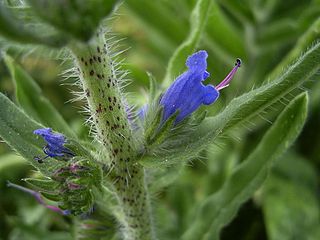
The tree ferns are the ferns that grow with a trunk elevating the fronds above ground level. Most tree ferns are members of the "core tree ferns", belonging to the families Dicksoniaceae, Metaxyaceae, and Cibotiaceae in the order Cyatheales.

This article relates to the flora of New Zealand, especially indigenous strains. New Zealand's geographical isolation has meant the country has developed a unique variety of native flora. However, human migration has led to the importation of many other plants as well as widespread damage to the indigenous flora, especially after the advent of European colonisation, due to the combined efforts of farmers and specialised societies dedicated to importing European plants & animals.

Cyathea dealbata, commonly known as the silver fern or silver tree-fern, or as ponga or punga, is a species of medium-sized tree fern, endemic to New Zealand. The fern is usually recognisable by the silver-white colour of the under-surface of mature fronds. It is a symbol commonly associated with the country both overseas and by New Zealanders themselves.

Cyathea cooperi, also known as the Australian tree fern, lacy tree fern, scaly tree fern, or Cooper's tree fern, is a tree fern native to Australia, in New South Wales and Queensland.
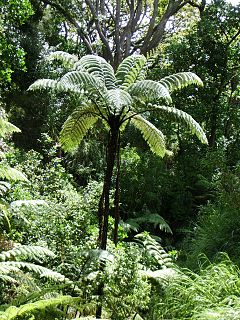
Cyathea medullaris, popularly known as the black tree fern, is a large tree fern up to 20 m tall. It is distributed across the south-west Pacific from Fiji to Pitcairn and New Zealand. It is called mamaku, katātā, kōrau, or pītau in the Māori language.

Cyathea brownii, commonly known as the Norfolk tree fern or smooth tree fern, is probably the largest tree fern species in the world. It is endemic to Norfolk Island, in the Pacific Ocean near Australia and New Zealand. It is named after the botanist Robert Brown (1773-1858).
Cyathea affinis is a variable species of tree fern native to Fiji, Samoa, the Cook Islands, Austral Islands, Tahiti, and the Marquesas Islands. The trunk of this plant is erect and 2–6 m tall. Fronds are bipinnate and 2–3 m in length. The rachis and stipe are pale to brown in colour, or flushed with red towards the pinnule rachis. The stipe is sparsely covered in narrow basal scales, which are pale to dark and have broad fragile edges. Characteristically of this species, the lowest one or two pairs of pinnae may be slightly reduced and occur towards the base of the stipe. Sori are located near the pinnule midvein and are partially or fully covered by indusia, which open towards the pinnule margin.

Cyathea aneitensis is a species of tree fern native to Vanuatu and possibly New Caledonia. This species has an erect trunk up to 3 m tall. Fronds are bipinnate and may reach 2 m in length. The rachis and stipe are either very dark and smooth or have a few scales towards the base of the stipe. The scales are dark and narrow. Sori occur near the pinnule midvein and are covered by large, thin, fragile indusia. The closest relative of C. aneitensis appears to be Cyathea vieillardii. It can be distinguished from that species by its very dark stipes and frond bases.

Cyathea australis, also known as the Rough Tree Fern, is a species of tree fern native to southeastern Queensland, New South Wales and southern Victoria in Australia, as well as Tasmania and Norfolk Island.
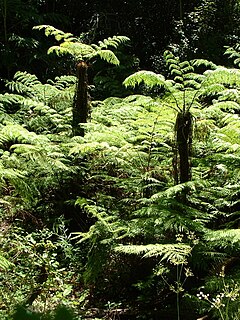
Cyathea capensis is a regionally widespread and highly variable species of tree fern. It is indigenous to Southern Africa and South America.

Cyathea cunninghamii, also known as the gully tree fern and slender tree fern, is a species of tree fern indigenous to New Zealand including North Island, South Island and Chatham Islands; also to Victoria, possibly New South Wales, southeastern Queensland and Tasmania in Australia. It grows in damp forest, often emerging from stream gullies and riverbanks. Brownsey noted that it has a lower tolerance for drought than other species of Cyathea. The erect trunk may be 20 m tall and is usually 6–15 cm in diameter, occasionally as much as 20 cm. Fronds are tri- to tetrapinnate and 3 m or more in length. The rachis and stipe are slender, black brown, warty and covered with brown scales. Sori occur along each side of the pinnule midvein and are covered by hood-like indusia. C. cunninghamii is an uncommon and slow-growing tree fern.

Cyathea dregei is a widespread species of tree fern in southern Africa.
Cyathea × marcescens, commonly known as the skirted tree fern, is a tree fern endemic to the Cape Otway ranges in Victoria and Tasmania, Australia. It is a natural hybrid, apparently Cyathea australis × Cyathea cunninghamii. Braggins and Large (2004) note that it has characteristics midway between these two species. The spores of C. × marcescens are usually malformed although sterile. The trunk of this plant is erect and up to 10 m tall. Fronds may be bi- or tripinnate and 3–4 m in length. Dead fronds often persist, forming a characteristic skirt around the trunk. The stipe is thick, black and warty. The rachis and trunk are covered in shiny, dark brown scales. Sori are borne near the fertile pinnule midvein and are protected by thin indusia that are saucer-like in appearance.

Cyathea glauca is a species of tree fern endemic to Réunion. Little is known about this species. C. glauca is not to be confused with Cyathea glauca used as a synonym of Cyathea mexicana.

Cyathea smithii, commonly known as the soft tree fern or kātote, is a species of tree fern from New Zealand.
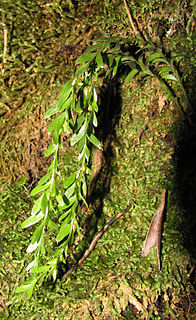
Tmesipteris the "hanging fork fern", is a genus of fern-like vascular plants, one of two genera in the family Psilotaceae, order Psilotales . Tmesipteris is restricted to certain lands in the Southern Pacific, notably Australia, New Zealand and New Caledonia. In New Zealand this hanging epiphyte is common in the warm temperate rain forests of both main islands, where it can normally be found as short spiky dark-green fronds, often with lighter bag-like sporangia at the bases of some of its "leaves". The plant possesses no true leaves; what appear to be leaves are flattened stems. The fronds emerge directly from the fibrous root-mats which clad the trunks of mature tree ferns such as Dicksonia and Cyathea. Tmesipteris is from the Greek language, meaning a "cut fern", referring to the truncated leaf tips.

Rumohra adiantiformis, commonly called leatherleaf fern, leather fern, leathery shieldfern, iron fern, 7-weeks-fern, and climbing shield fern, is a species of fern in the family Dryopteridaceae.
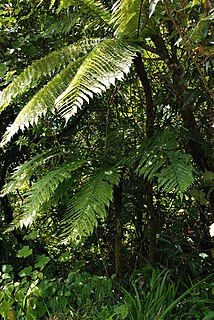
Cyathea borbonica is a tree fern endemic to Mauritius, Réunion and the islands of the south-western Indian Ocean. There are several natural forms and varieties.

Cyathea howeana is a fern in the Cyatheaceae family. The specific epithet refers to Lord Howe Island, the locality to which it is endemic in Australia.

Cyathea robusta is a fern in the Cyatheaceae family. The specific epithet alludes to its robust habit.




